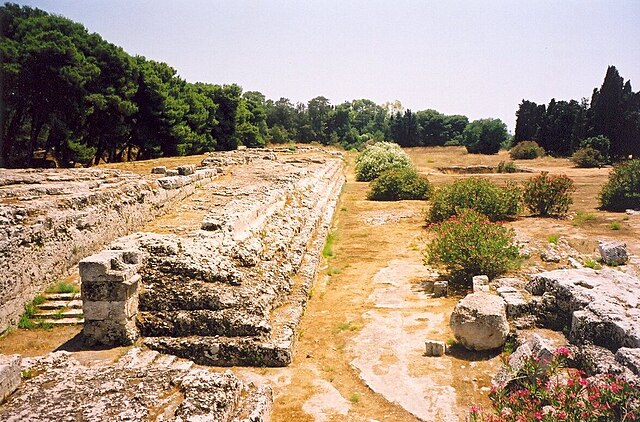Loading AI tools
King of Syracuse From Wikipedia, the free encyclopedia
Hiero II (Ancient Greek: Ἱέρων; c. 308 BC – 215 BC), also called Hieron II, was the Greek tyrant of Syracuse, Greek Sicily, from 275 to 215 BC, and the illegitimate son of a Syracusan noble, Hierocles, who claimed descent from Gelon.[1] He was a former general of Pyrrhus of Epirus and an important figure of the First Punic War.[2] He figures in the story of famed thinker Archimedes shouting "Eureka".



When Pyrrhus left Sicily (275 BC) the Syracusan army and citizens appointed Hiero commander-in-chief. He strengthened his position by marrying the daughter of Leptines, one of the leading citizen of Syracuse. In the meantime, the Mamertines, a body of mercenaries from Campania who had been employed by Agathocles the late tyrant of Syracuse, had seized the stronghold of Messina, and proceeded in harassing the Greeks around them. They were finally defeated in a pitched battle near Mylae along the Longanus river by Hiero, who was only prevented from capturing Messina by Carthaginian interference. His grateful countrymen then made him king (275) but unlike the past kings or tyrants of Syracuse he ruled within the law and ruled with the assemblies of Syracuse and never purged his opponents.[1]
In 264 BC he returned and attacked the Mamertines again. The Mamertines became desperate and called in the aid of Rome.[3] Hiero at once joined the Punic leader Hanno, who had recently landed in Sicily; but fighting a battle to an inconclusive outcome with the Romans led by the consul Appius Claudius Caudex, he withdrew to Syracuse.[4][1]
Pressed by the Roman forces, in 263 he concluded a treaty with Rome, by which he was to rule over the south-east of Sicily and the eastern coast as far as Tauromenium.[1][4]
From this time until his death in 215 BC he remained loyal to the Romans, and frequently assisted them with men and provisions during the Punic war.[5] He kept up a powerful fleet for defensive purposes, and employed his famous kinsman Archimedes in the construction of those engines that, at a later date, played so important a part during the siege of Syracuse by the Romans.[1]
According to a story told by Vitruvius,[6] Hiero suspected he was being cheated by the goldsmith to whom he had supplied the gold to make a votive crown for a temple. He asked Archimedes to find out if all the gold had been used, as had been agreed. Archimedes, on discovering the principle of displacement needed to measure the density of the crown is said to have shouted "eureka, eureka!" while running naked through Syracuse. Supposedly, it was while noticing the rise in water level when getting a bath tub that Archimedes realized he could use water-displacement to measure the crown's irregular shape, and in his excitement about the discovery he dashed outside cheering and forgot to dress himself first. Vitruvius concludes this story by stating that Archimedes' method successfully detected the goldsmith's fraud; the smith had indeed taken some of the gold and substituted silver instead.
A picture of the prosperity of Syracuse during his rule is given in the sixteenth idyll of Theocritus, his favourite poet.[1][7] During the reign of Hieron II, various forms of architectural decoration were introduced in Sicily, which are summarised as ‘Hieronic architecture’. Contrary to some assumptions in scholarship, however, there is no evidence that these stylistic innovations were the result of a central programme on Hieron's part to legitimise his rule.[8]
In the 16th century treatise The Prince (Chapter 6), Machiavelli cites Hiero as an exceptionally virtuous man and a rare example of someone who rose to princely power from previously being a private individual, comparing him to Moses, Cyrus, Theseus, and Romulus.
Seamless Wikipedia browsing. On steroids.
Every time you click a link to Wikipedia, Wiktionary or Wikiquote in your browser's search results, it will show the modern Wikiwand interface.
Wikiwand extension is a five stars, simple, with minimum permission required to keep your browsing private, safe and transparent.